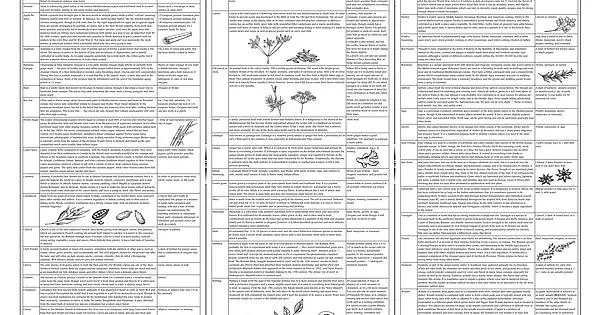cross-posted from: https://slrpnk.net/post/847900
A few years ago, while we were cooking, my SO showed me a blog post about common spices and their substitutions. I thought it’d be cool to use that to make a chart we could hang on the wall.
It turned into a fun light research project, then a fun art project.
I started reading various blogs and realized that while many covered the same core spices, there were a lot of others that only one blog or another mentioned. So I started gathering them all up.
As I read about them on Wikipedia I’d stumble into their histories, and scope creep hit. I decided to add a column for interesting facts about each. (While gathering those, I was kind of struck at the disparity between them - some spices, have centuries of warfare, murder, and espionage wrapped around them, while others are so common or easy to grow that nobody seems to have stabbed anyone at all for it.)
I built it first as a spreadsheet in Google sheets while I was researching, pasted it into a poster-size libre office writer document for layout and font changes, exported that as a pdf so I could import it into GIMP. That let me make more detailed changes and add the flourishes that hopefully make it look like something that might’ve hung on the wall in your grandparents’ kitchen.
This was a pretty casual project spread over seven months. It’s got forty-some spices with descriptions, fun facts, and substitutions shamelessly plagiarized from cooking blogs and Wikipedia.
I’ve learned since that several spices are actually really unspecific, like what’s sold as oregano apparently may come from several different plants. So I’ll say it’s useful for cooking and accurate to the best of my ability, but I wouldn’t reference it as a historical or scientific resources.
If you want to print it out, I uploaded the PDF here: https://jacobcoffinwrites.files.wordpress.com/2023/07/spice_list_printable.pdf
Thanks for this! Cardamom is one of my favorites because that’s what makes Swedish pancakes so good! Just remember… a little goes a long damn way!
My grandmothers pancake recipe, just add about a teaspoon or two of cardamom.
1 Qt. Buttermilk
2 TBS Baking Soda
1 TBS Salt
4 Cups Flour
2 TBS Baking Powder
1 Pkg Dry Yeast
1/4 C. Oil
6 EggsPut 1 quart buttermilk in large bowl and add 2 TBS Baking SODA and 1 TBS Salt.
Mix 4 cups of flour with 2 TBS Baking POWDER, stir this mixture into the buttermilk.
Add one package of dry yeast, 1/4 cup oil. Mix.
Whip 6 eggs till foamy, fold in mixture. Do not use electric mixer, use mixer tine by hand.
Pour batter into large pitcher or bowl. Cover with foil and let sit overnight.
The next morning put a cup of milk in the pitcher to thin the batter.
Heat pan until hot. Add 3 TBS or so of oil, when water droplets sizzle in the pan it’s ready. Cook pancakes in 2s or 3s. When the tops are covered in steam-holes then it’s ready to flip. 2 to 3 minutes or so.
Lasts 10 days to 2 weeks in fridge. Yeast will turn black over time, this is normal. Stir batter before use.
These sound amazing and I’m definitely saving this recipe!
Be warned… it makes a BUNCH!
While that sounds delicious it has nothing to do with Sweden. We dont have buttermilk and I’ve never heard anyone putting cardemom into pancakes. Or yeast.
We just use milk, egg, flour and salt. Whisky together and fry in butter, makes thin and crispy pancakes.
I’m saving this. Damn informative, and pretty!
Thanks, glad you like it!
Thank you so much! As someone with oral allergy syndrome, I can’t have some spices and it really makes dishes bland. I’m looking forward to trying these!
Awesome! I hope it helps! Best of luck
How about an image host that doesn’t force JavaScript? This looks interesting, but it won’t load
Bam! Thanks!
Not to look a gift horse in the mouth, but this would probably be great as a PDF or other vector image. Its pretty pixelated on my end, but still legible. Thx for the resource!
Whoops, this should be higher rez, didn’t realize movim was compressing it
https://mega.nz/file/mR8iGbII#fVw3lCzdpxsyp60cOl50-HO93sYHpZm-Y125XnnPXn0
And the pdf version is available here: https://jacobcoffinwrites.files.wordpress.com/2023/07/spice_list_printable.pdf
Back to not loading for me, but no worries – its my choice to avoid JS, not yours to find workarounds for me.
I appreciate all the effort you put in to this, but I think this could have much greater impact as a simplified infographic if possible.
To be honest, I don’t think I plan to do anything else with this project, but I still have the libreoffice document with selectable text and I’m happy to share it if you or anyone wants to use it to make something new.
https://mega.nz/file/edcmEAbA#EPFIg2YGU0e9L_SjVp6UT-Q6dMbmBLVDCdVab_-IrUE
Understood, again it looks like it took a lot of time and is obviously very thorough.






